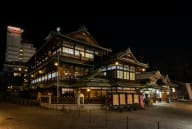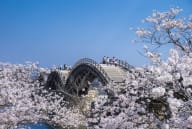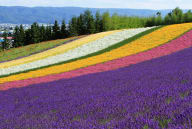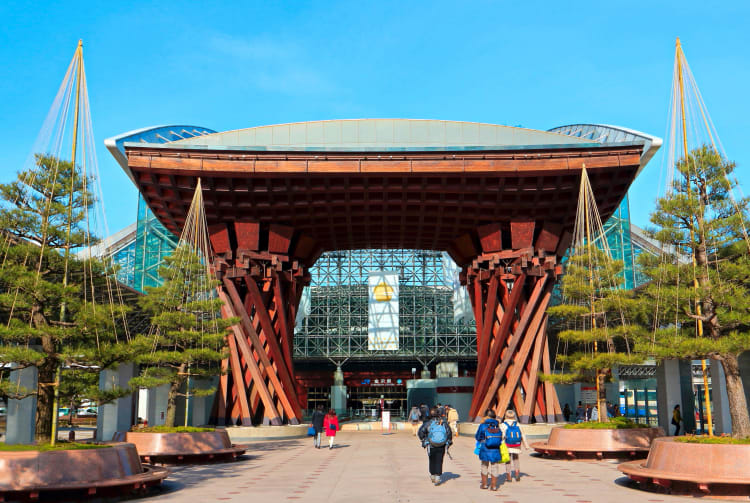Votre aventure culturelle à Ishikawa commence ici
Cette gare remarquable est votre point de départ pour une exploration plus approfondie de Kanazawa et des zones voisines de la préfecture d'Ishikawa (anciennement connues sous les noms de Kaga, Echizen et Noto avant notre ère). Certains de ces noms de grands royaumes disparus subsistent encore à travers les noms des lieux et des familles, comme la péninsule de Noto et l'onsen de Kaga .
Construite en 1898, la gare de Kanazawa a fait l'objet d'une rénovation majeure en 2005 avec un design futuriste comprenant un dôme en verre et en acier, et une porte géante en bois ressemblant à un torii, le portail qu'on trouve dans les sanctuaires japonais. Kanazawa est la capitale culturelle et économique de la région de Hokuriku .
À ne pas manquer
- L'impressionnante porte Tsuzumi-mon devant la gare
- La glace à la feuille d'or
- Le marché d'Omicho situé à deux pas de la gare
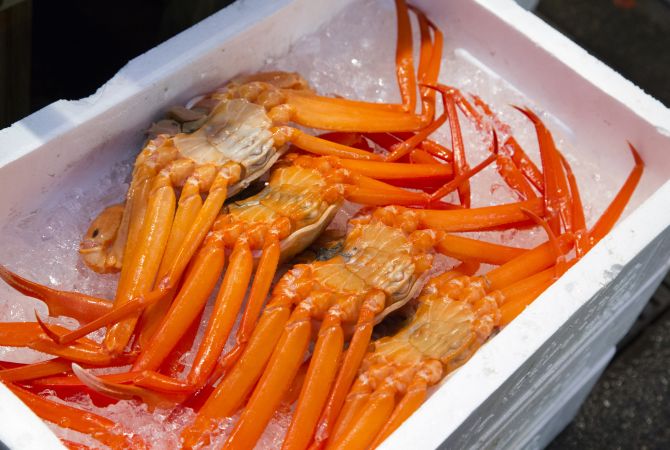

Comment s'y rendre
Avec l'introduction en 2015 de la Hokuriku Shinkansen Line reliant Tokyo à Kanazawa, la ville est devenue beaucoup plus facile d'accès. De nombreux touristes découvrent aujourd'hui ce joyau caché de la culture japonaise.
La gare de Kanazawa est accessible depuis plusieurs grandes villes du Japon et se trouve à environ deux heures et demie de Tokyo et de Kyoto via le train à grande vitesse et le train express. Consultez la page principale de Kanazawa pour en savoir plus sur les lignes desservant la gare de Kanazawa.
Anecdotes
La gare de Kanazawa est considérée comme l'une des plus belles gares du Japon
La gare a été conçue par l'architecte Ryuzo Shirae et achevée en 2005
Apprenez à vous orienter
À votre arrivée à Kanazawa, vous serez immédiatement frappé par le design moderne et épuré de la gare, ses touches subtiles d'or et ses décors traditionnels, ainsi que son vaste hall séparant les sorties est et ouest. La gare abrite des supérettes, des distributeurs automatiques de billets et une aire de restauration où vous trouverez les spécialités de Kanazawa : des boîtes à bento colorées mettant en vedette les mets typiques d'Ishikawa.
Un centre d'information touristique est situé en face des portiques du JR Shinkansen. Arrêtez-vous pour y récupérer des plans et les horaires des bus, ou même pour réserver un guide bénévole local à la journée (les réservations doivent être faites deux semaines à l'avance).
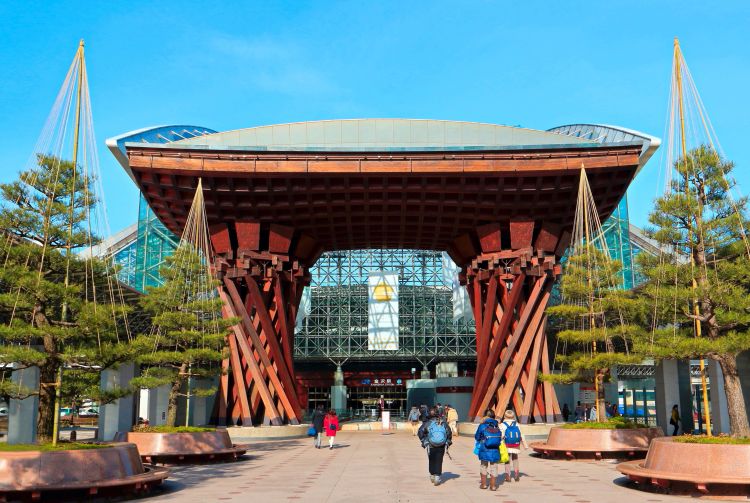
La porte Tsuzumi-mon de la gare de Kanazawa, symbole de grandeur et de noblesse
Design, architecture et espaces publics
Considérée dans un premier temps comme une structure moderne peu esthétique, la gare de Kanazawa est devenue un symbole de la ville. L'impressionnante porte Tsuzumi-mon, conçue pour ressembler à un tambour traditionnel utilisé dans les pièces de nô, est construite avec du sapin de Douglas japonais. Le gigantesque dôme Motenashi qui surplombe la hall de la sortie n'est pas seulement majestueux, il protège aussi les voyageurs de la pluie et des chutes de neige fréquentes dans la région.
Autour de la gare
La gare abrite toutes sortes de magasins et dans le centre commercial Hyakubangai, des enseignes modernes côtoient des boutiques d'artisanat local à la feuille d'or et de souvenirs.
La feuille d'or de Kanazawa remonte à l'époque Azuchi Momoyama (1568-1603). Pendant l'ère Meiji (1868-1912), l'industrie était florissante. Grâce à une technologie avancée de dorure à la feuille, Kanazawa est devenu le premier producteur de feuilles d'or, d'argent et de cuivre du pays, concentrant aujourd'hui près de 100 % de la production japonaise. Cette industrie a fait la richesse de Kanazawa dans le passé et continue de la faire à ce jour.
Un hôtel est situé à l'intérieur même de la gare, et à environ deux minutes se trouvent les grands hôtels ANA Crowne Plaza et Nikko Kanazawa Hotel.
Les transports en ville
Tous les sites touristiques populaires de Kanazawa sont accessibles en bus ou en taxi depuis la sortie est. Un centre d'information sur les transports, situé juste à l'extérieur de la sortie est, vous renseignera sur la façon de vous rendre aux principales attractions de la ville, comme le château de Kanazawa et le jardin Kenrokuen . Le Kanazawa Loop Bus et le bus Kanazawa Light Up sont tous deux pratiques et faciles à utiliser. Si vous n'avez rien contre un peu d'exercice, vous pouvez rejoindre le marché d'Omicho à pied en 15 minutes depuis la gare. Enfin, pour environ 1000 yens, les taxis vous emmènent n'importe où dans le centre de Kanazawa.
Deux des atouts de la région
Adjacent au château de Kanazawa , le jardin Kenrokuen est la plus belle pépite de la ville. Comme beaucoup de beaux jardins au Japon, Kenrokuen séduit par ses étangs pittoresques, ses fleurs de prunier et de cerisier au printemps, ses azalées et ses iris au début de l'été ou encore ses feuilles rouges et jaunes en automne.
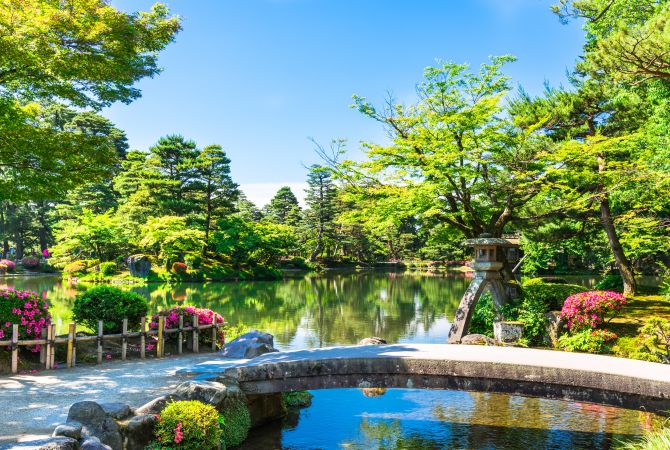

Le jardin Kenrokuen
La formule secrète qui distingue le jardin Kenrokuen des autres réside dans son nom. Kenrokuen signifie avoir six éléments. On lui a donné ce nom en raison des six qualités qui font ressortir le paysage parfait de ce jardin : l'espace, la tranquillité, l'artifice, l'ancienneté, les points d'eau et les vues magnifiques.
Le marché d'Omicho offre un tout autre type de richesse. Il est animé, bruyant, coloré et souvent bondé. C'est le plus grand marché d'aliments frais de Kanazawa.


Le marché d'Omicho
Le marché abrite environ 170 magasins, la plupart spécialisés dans les produits de la mer, mais vous y trouverez également des fleurs, des ustensiles de cuisine et même des vêtements. C'est toutefois pour ses produits frais que la plupart des gens s'y rendent. Et c'est aussi pourquoi on le surnomme la cuisine de Kanazawa. Marchandez avec les vendeurs pour acheter un crabe géant, des pétoncles ou des huîtres géantes. Mais à moins que vous ne soyez prêt à les manger crus ou sur le barbecue du marché, arrêtez-vous dans l'un des restaurants du marché d'Omicho . Le marché se compose de deux étages, mais le meilleur poisson frais se trouve au 1er étage.
Rapportez un souvenir
Avant de partir pour votre prochaine destination ou de prendre le chemin du retour, n'oubliez pas de goûter aux glaces à la feuille d'or. Les souvenirs les plus populaires à rapporter de Kanazawa , que vous trouvez à la gare, sont du saké local, des douceurs japonais, des produits de beauté à base de feuilles d'or, des serviettes pour les mains ainsi que des objets en laque japonaise.
















